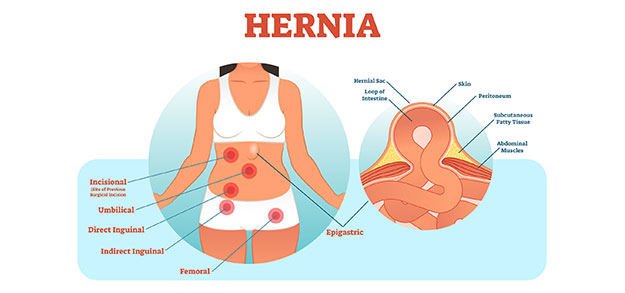
Approximately 2-3 percent of abdominal hernias are epigastric hernias, which can affect all age groups, from infants and children to adults.
If the abdominal wall becomes weak in the area between the belly button (umbilicus) and sternum (breastbone) and a hole develops that allows tissues to push through, the result is what's called an epigastric hernia.
While it's common to experience no symptoms at all with hernias of this nature, treatment is eventually necessary for most patients since epigastric hernias will not heal on their own.
Epigastric Hernia Causes and Symptoms
It's not fully known what causes epigastric hernias. In infants, this type of hernia may be present at birth if the abdominal wall doesn't fully close. It's also believed that epigastric hernias may develop if there is tension at the point where the abdominal wall links to the diaphragm in the epigastric region. An epigastric hernia may produce a visible bump where tissues are protruding above the naval area. It's also possible to simultaneously have more than one epigastric hernia. Should symptoms appear in a non-emergency situation, they usually involve some degree of discomfort or tenderness within the epigastric region.


Diagnosing an Epigastric Hernia
When present at birth, this type of hernia may seem to randomly appear and disappear (a reducible hernia). In very young patients, the problem may not be evident until an infant begins to cry or experience difficulty with bowel movements. An initial diagnosis is often made when there is a noticeable bulge in the affected area. In some instances, an epigastric hernia may be detected when a patient has a CT scan or another type of image test for a different reason. If a bulge isn't noticeable and there no symptoms, epigastric hernias may go undiagnosed.
Treatment Options
Because an epigastric hernia is likely to enlarge over time and contribute to additional complications, surgery is typically the recommended treatment, even for very young patients. However, surgery may be postponed until an infant is older if issues related to this type of hernia aren't severe or life-threatening.
If the tear or hole is minor, surgical repair may be done with minimally invasive techniques and a few sutures. If the damage is more extensive, mesh may be used to close the hole to reduce the risk of developing another epigastric hernia after surgery is completed.
While precautions are taken during any type of hernia surgery, serious complications may develop when surgery is performed to correct protrusions in the affected area. Patients are urged to seek immediate medical attention if there is an unusual discharge from the surgical site, bleeding that's not stopping, a high fever, difficulty urinating, or pain in the affected area.
Emergency Situations
If an epigastric hernia goes untreated long enough, a bowel blockage may occur. Should this happen, symptoms experienced may include nausea and vomiting, high fever, and increased abdominal pain. When such symptoms appear, immediate medical treatment is necessary. Treatment should also be sough if a hernia is permanently in the "out" position (incarcerated hernia). This isn't necessarily an emergency, but hernias like this are more likely to starve the blood supply of protruding tissues (a strangulated hernia).
Most people respond well to surgery performed to treat an epigastric hernia. Patients are generally advised not to carry anything heavier than a gallon of milk until recovery is complete after about 6-8 weeks. However, restrictions on heavy lifting and strenuous activities may extend beyond this point. Recommendations specific to a return to normal personal and work-related activities will be made on an individual basis.
